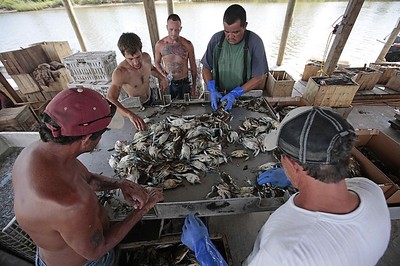Previously on Cornichon:
How to eat, what to eat, is the new question of our time, but we have become introspective and fearful in this Internet age. We wash our hands with germicidal soap, only to learn that the antibacterial chemical triclosan penetrates the skin and messes with our endocrine system. We buy "fat-free" half & half. made with corn syrup solids, sugar, and carageenan. Carnuba wax, used for polishing cars when we were kids; is in today's processed foods by the ton.A Seattle Times story detailed new problems facing oyster growers on the Hood Canal: rising acidity levels in Puget Sound waters. But there are far more serious environmental threats to our food supply, one by land and two by sea.
The first, BP's recently capped underwater gusher, devastated the Gulf of Mexico's fishing industry. The second, a proposed open-pit mine in Alaska, could extinguish the salmon run in Bristol Bay. And the third, a vast heap of nuclear waste at the Hanford Nuclear Reservation, threatens eastern Washington's agricultural heartland and world-renowned vineyards. The next three days, we'll take a look.
 "Doonesbury" skewered BP's inept public response to the Gulf oil rig explosion and questions about seafood safety also found their way into the comic strip: blackened shrimp, oil-soaked scallops, and tar-encrusted crab were all on the menu at the fast-food emporium where Zonker works.
"Doonesbury" skewered BP's inept public response to the Gulf oil rig explosion and questions about seafood safety also found their way into the comic strip: blackened shrimp, oil-soaked scallops, and tar-encrusted crab were all on the menu at the fast-food emporium where Zonker works.
In Seattle, the mood is grim. Kevin Davis, co-owner of Steelhead Diner and Blueacre Seafood knows, more than anyone in town, what the stakes are. A native of Louisiana whose father was a drilling superintendent for Shell Oil, Davis grew up fishing in bayous and marshes that are now black with tar. Still, he's hopeful: "The fisherman know it's bad, but they're saying, 'Don't abandon us.'"
Davis's professional colleagues around the country agree. Chefs Collaborative, a national organization that fosters a sustainable food system, published a booklet last month titled Foods at Risk in the Gulf Coast that was both cautionary and motivational. "As chefs, we need to support Gulf food producers as best we can," it concluded. "Our support is critical to keeping our food culture alive and the local economy from collapsing."
Still, WalMart has suspended the sale of seafood in Florida because of rising prices and falling demand. In Seattle, it's hard to find 'Gulf Prawns" or "Louisiana Crabmeat" on the menu anywhere. Crayfish, being a freshwater species, are safe, so far, although, at last report, oil had found its way into the larvae of blue crab and fiddler crab, a particularly bad sign for the speckled trout that feed on the crustaceans. To say nothing of the disruption of the blue fin tuna's spawning grounds in the Gulf. But the least fortunate of the Gulf's creatures would appear to be its oysters, once wildly abundant, now on the road to extinction. And the Gulf's communities of African-American oystermen, sad to say, appear to have been excluded from the (paying) jobs of cleaning up the mess.
For its part, BP has been running ads taking responsibility, not necessarily for the gusher but for the cleanup: "We'll make this right." But complaining that in order to pony up the $20 billion they've promised in damages, they've got to continue deep-water drilling.
Tomorrow: Alaska's Bristol Bay
Leave a comment